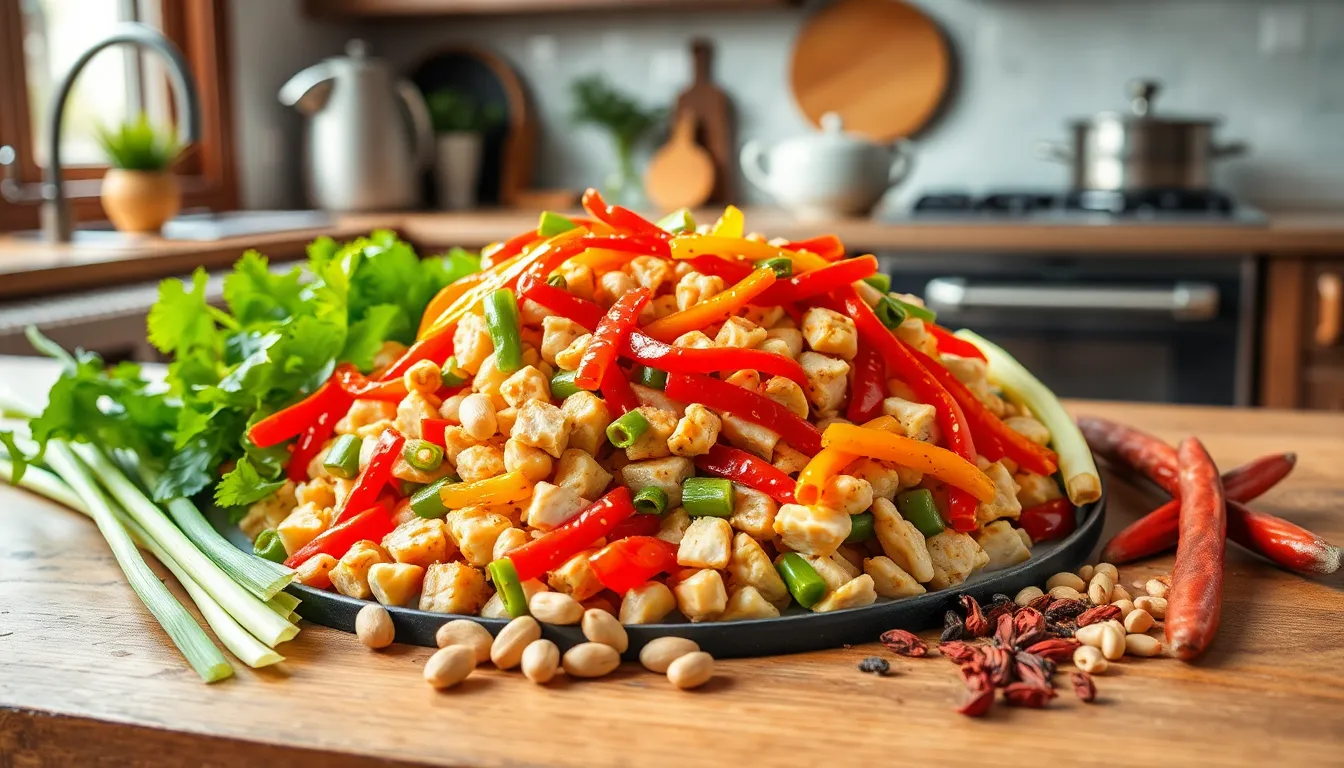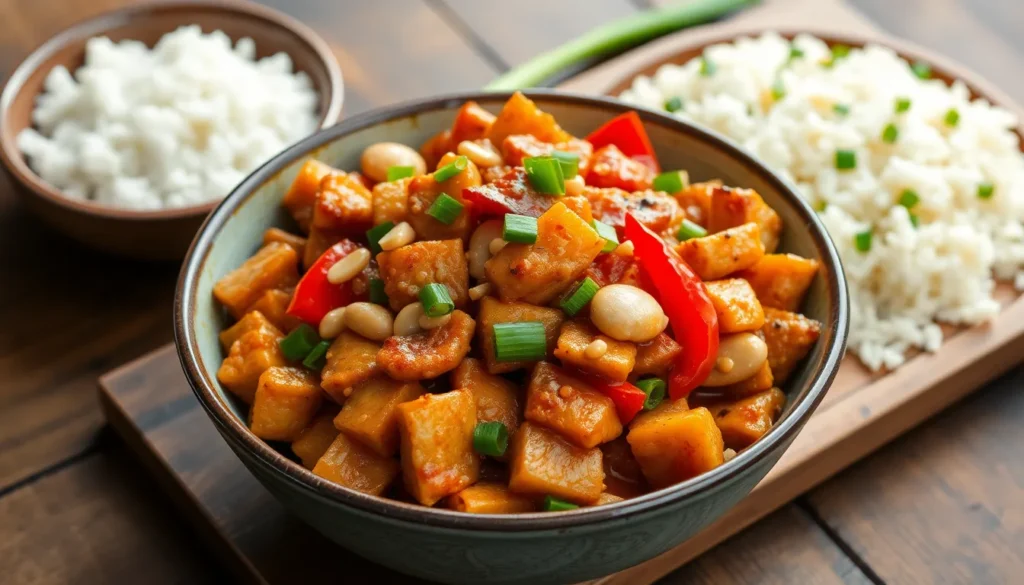Table of Contents
ToggleKung Pao Chicken isn’t just a dish; it’s a culinary adventure that takes taste buds on a wild ride. Picture this: tender chicken, crunchy peanuts, and a spicy kick that’ll make you question why you ever settled for takeout. This isn’t your average stir-fry; it’s a flavor explosion that’ll have your friends begging for the secret recipe.
Overview of Kung Pao Chicken
Kung Pao Chicken originates from Sichuan province in China. It aligns spicy ingredients with the delightful crunch of roasted peanuts. Traditionally, diced chicken cooks quickly in a hot wok, absorbing flavors from soy sauce, vinegar, and sugar. The dish enjoys popularity worldwide, appealing to those who appreciate bold flavors.
Authentic versions feature Szechuan peppercorns, combining heat with a unique numbing sensation. This balance enhances the overall taste, making each bite memorable. Many chefs incorporate vegetables such as bell peppers and green onions for added texture and color.
Preparation involves marinating the chicken in a mix of soy sauce and cornstarch, allowing it to develop a rich flavor. Cooking occurs in stages to ensure even distribution of flavors and textures. Nuts contribute both crunch and protein, elevating the dish beyond a simple stir-fry.
Serving Kung Pao Chicken often happens over steamed rice, allowing the spicy sauce to soak into the grains. Individual preferences may lead to variations, including additional ingredients or altering spice levels.
This dish not only satisfies cravings but also showcases the artistry of Chinese cuisine, standing out in both home kitchens and restaurants. Enjoying Kung Pao Chicken offers a glimpse into the rich culinary traditions from which it emerges.
Ingredients for Authentic Kung Pao Chicken

This section details the essential components for crafting an authentic Kung Pao Chicken. Gathering the right ingredients ensures a flavorful result that honors the dish’s origins.
Main Ingredients
Diced chicken breast provides the primary protein base, giving the dish its tender texture. Using fresh bell peppers adds vibrant color and crunch. Roasted peanuts contribute a satisfying nuttiness, enhancing each bite. Spring onions offer a fresh onion flavor, balancing the richness of the sauce. Soy sauce serves as the primary seasoning, delivering depth and umami. Cornstarch is essential for marinating, ensuring the chicken’s tenderness. Shaoxing wine introduces a layer of complexity, typical in traditional recipes. Functioning together, these ingredients create a harmonious blend that characterizes Kung Pao Chicken.
Spice Elements
Szechuan peppercorns deliver a unique tangy heat, elevating the dish’s spiciness. Dried red chilies provide a direct kick, presenting layered flavors throughout. Garlic and ginger enhance the aromatic profile, ensuring a fragrant experience. An optional splash of rice vinegar adds sharpness, balancing sweetness from the sauce. Chili paste can intensify the overall spice level, adapting to individual preferences. Each spice element works in concert, emphasizing the dish’s distinctive characteristics while staying true to authentic Chinese cuisine.
Step-by-Step Cooking Instructions
Creating authentic Kung Pao Chicken involves precise preparation and careful cooking techniques. Follow these detailed steps for an exceptional dish.
Preparation of Ingredients
Gather all essential ingredients before starting the cooking process. Start by dicing the chicken breast into bite-sized pieces for even cooking. Next, chop fresh bell peppers into uniform shapes to maintain texture and visual appeal. Roast peanuts contribute a delightful crunch, so measure out about half a cup. Slice spring onions into small sections for garnish and flavor enhancement. For added complexity, prepare garlic and ginger by mincing them finely. Finally, set aside Szechuan peppercorns and dried red chilies to incorporate that signature heat. Use Shaoxing wine and soy sauce in separate bowls for easy access during cooking.
Cooking Process
Begin by marinating the diced chicken with soy sauce and cornstarch, allowing it to absorb the flavors. Heat a wok or large skillet over high heat and add vegetable oil until it’s shimmering. Add marinated chicken to the hot wok, stirring quickly to ensure even cooking. Once the chicken shows a golden color, remove it from the wok and set aside. In the same wok, toss in minced garlic, ginger, and dried red chilies, stirring briefly to release their aromas. Combine the roasted peanuts and bell peppers next, sautéing until they soften. Return the chicken to the wok, followed by a mixture of soy sauce, sugar, vinegar, and Shaoxing wine. Ensure everything mixes thoroughly for a burst of flavor, finishing with spring onions for freshness. Serve with steamed rice for a complete meal.
Tips for Perfecting Your Kung Pao Chicken
Perfecting Kung Pao Chicken involves attention to detail and personal preference. Various methods can enhance flavors and textures, ensuring an unforgettable dish.
Adjusting Spice Levels
Adjusting spice levels allows for customization according to personal tastes. Increase or decrease Szechuan peppercorns to modify the numbing sensation. Adding more or fewer dried red chilies provides additional control over heat intensity. It’s important to taste the dish as it cooks, enabling real-time adjustments to the spice profile. Balancing the heat with sweet or tangy ingredients can create a well-rounded flavor. For those who prefer milder flavors, consider reducing the number of chilies or omitting them entirely. Spice level alterations can transform Kung Pao Chicken into a personalized masterpiece.
Authentic Serving Suggestions
Serving Kung Pao Chicken authentically enhances the dining experience. Pairing it with fluffy steamed rice creates a comforting, satisfying meal. Offering side dishes like stir-fried vegetables or a fresh cucumber salad adds texture and freshness. Garnishing with chopped scallions not only enhances presentation but also complements the dish’s flavor profile. Consider serving with crispy spring rolls to provide a delightful contrast. Typically, a bottle of soy sauce on the side allows diners to adjust the dish to their liking. Serving options create a complete meal that celebrates the authentic essence of Kung Pao Chicken.
Creating an authentic Kung Pao Chicken at home is not just about following a recipe; it’s about embracing the flavors and techniques that make this dish a beloved classic. With its perfect balance of spice and crunch it’s sure to impress anyone lucky enough to share the meal.
By experimenting with ingredients and adjusting spice levels, cooks can make this dish their own while still honoring its rich heritage. Whether served over rice or alongside fresh vegetables, Kung Pao Chicken offers a delightful culinary experience that transports diners straight to Sichuan. Enjoying this dish allows for a deeper appreciation of Chinese cuisine and its vibrant flavors.







